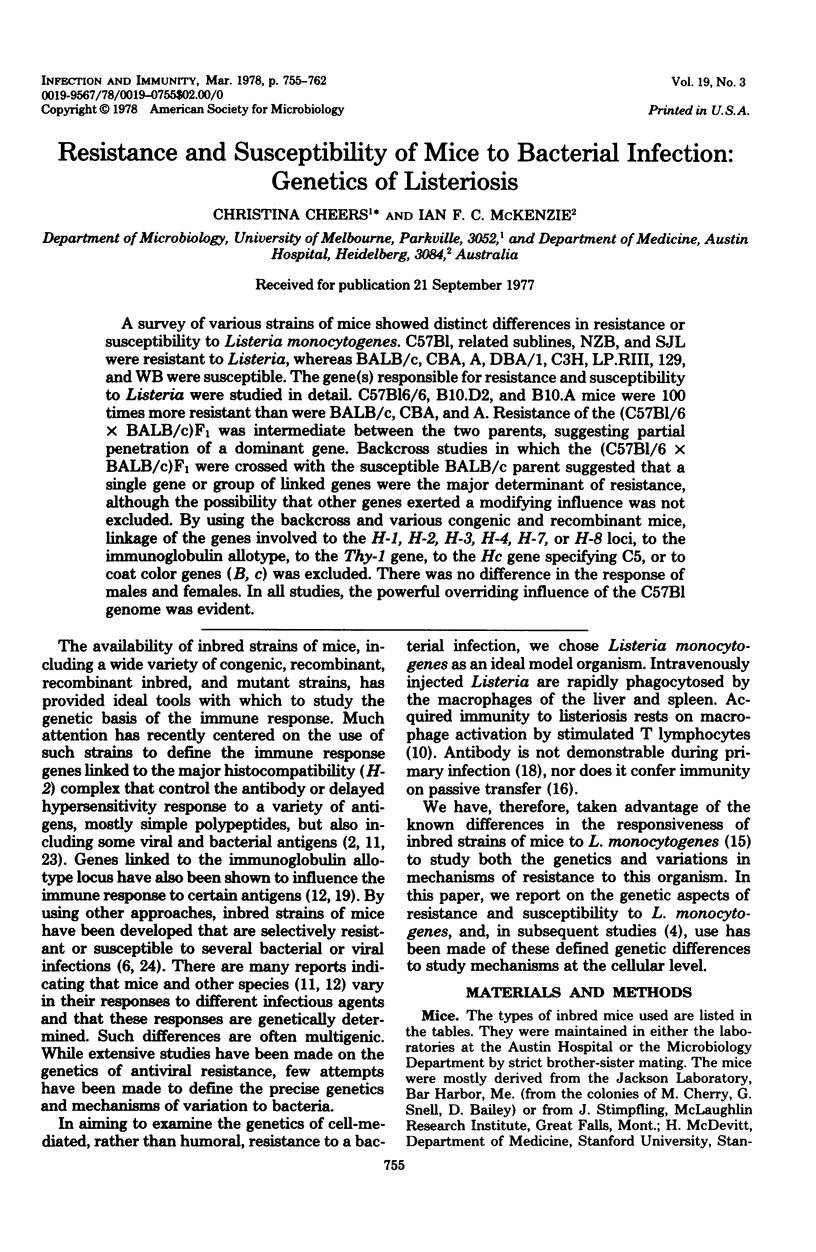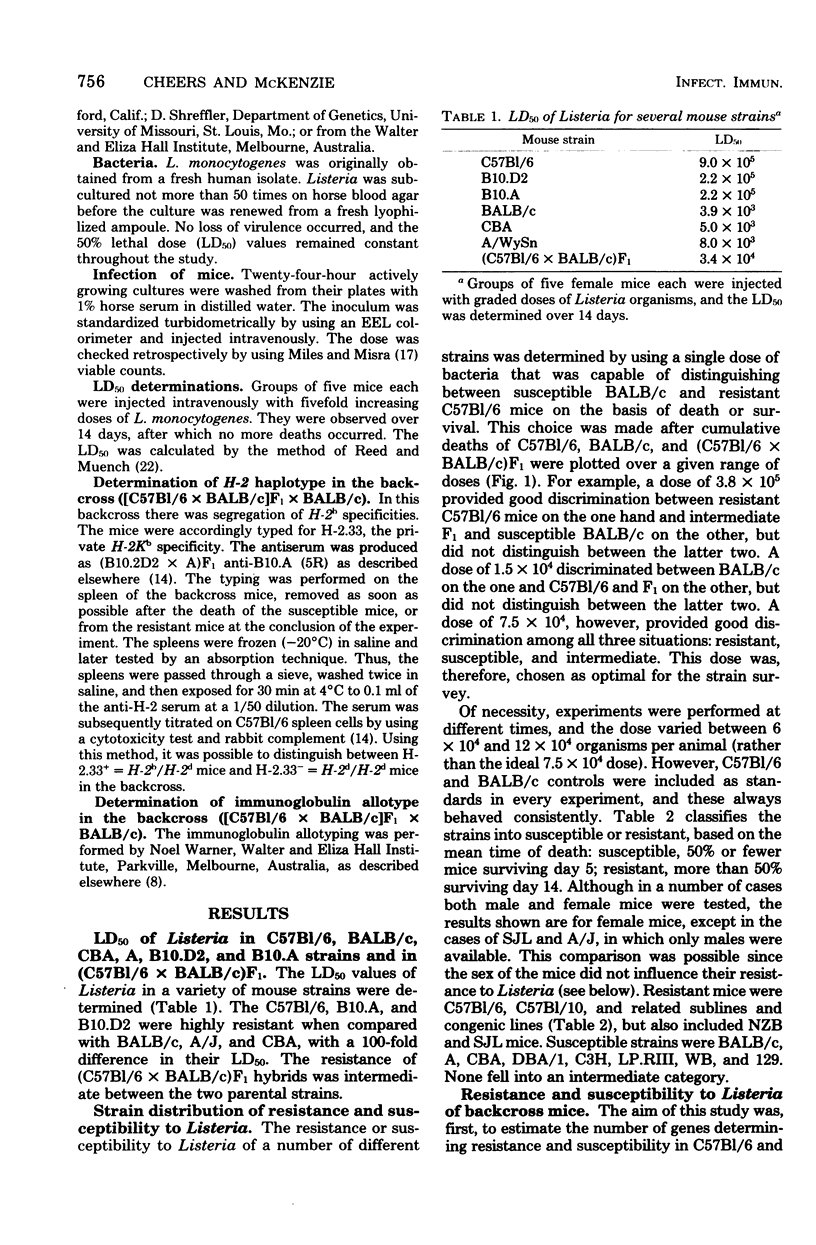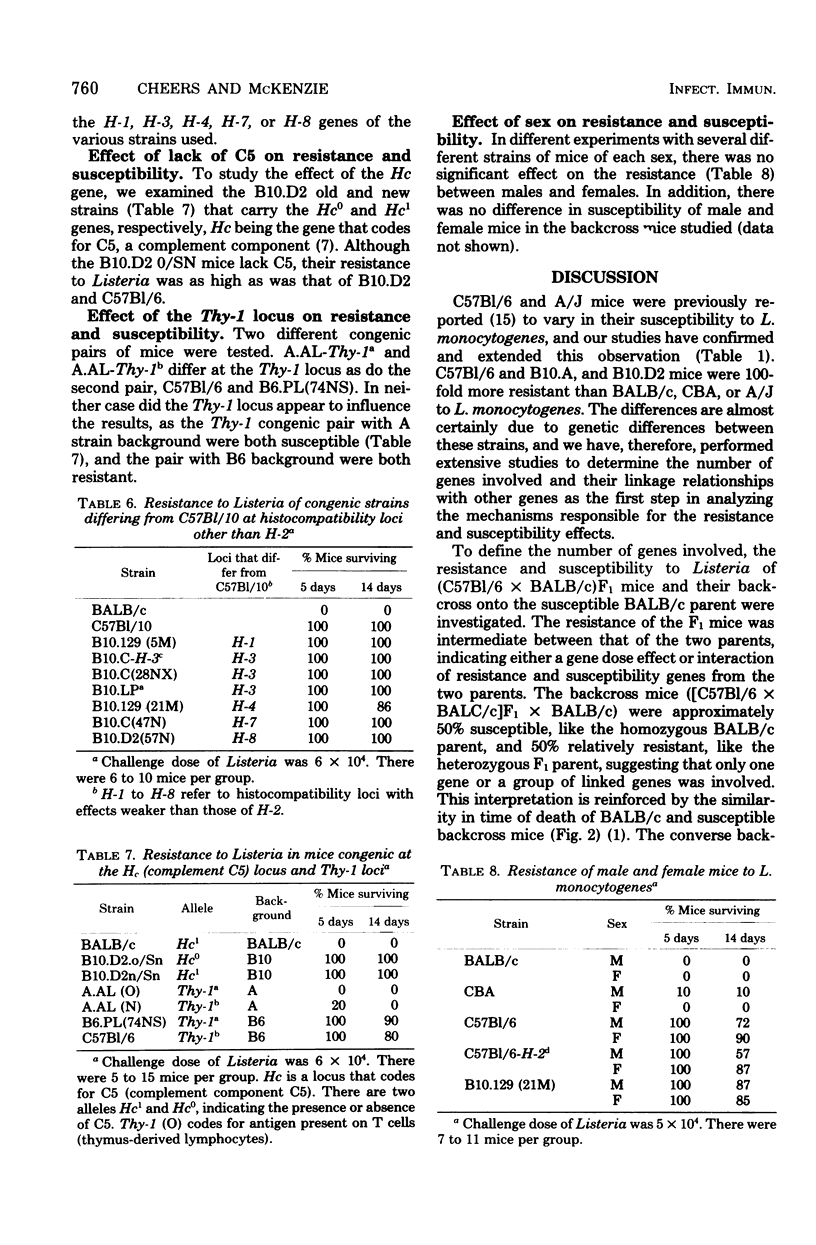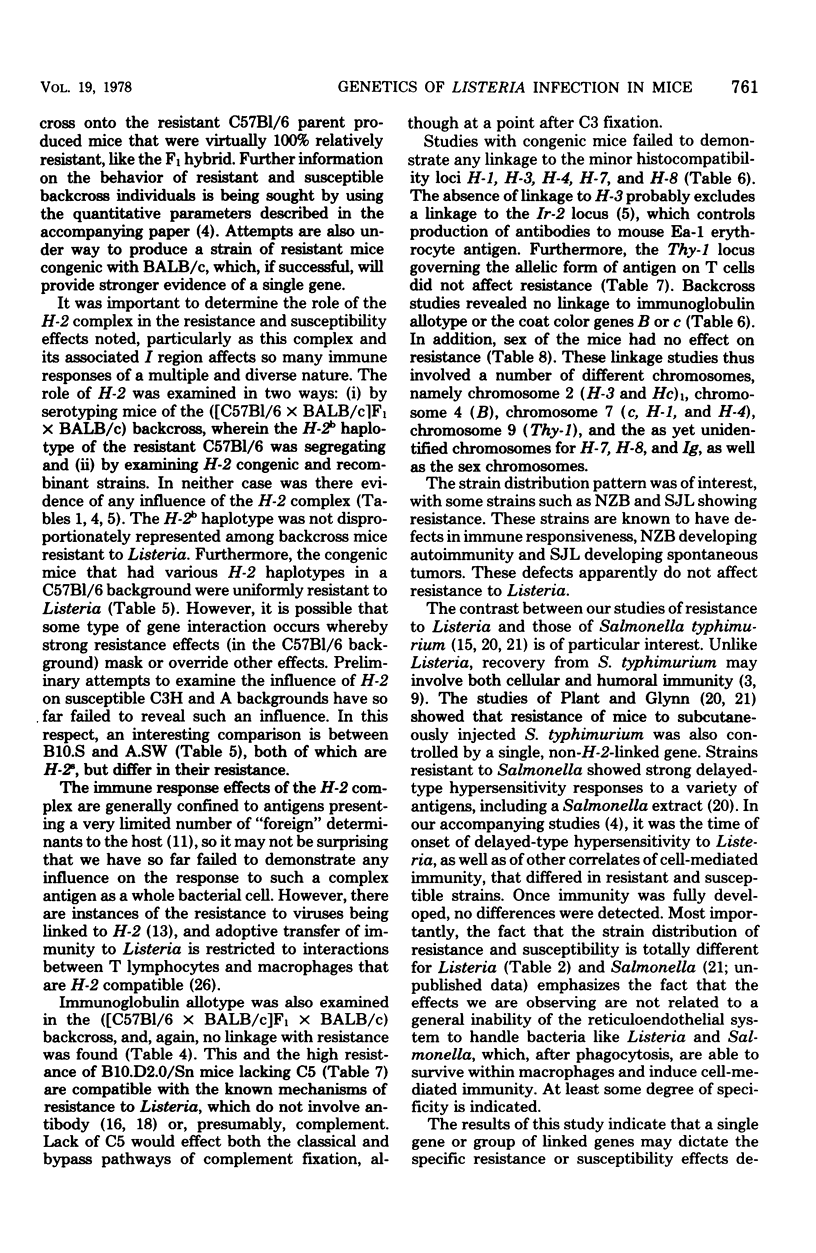Abstract
A survey of various strains of mice showed distinct differences in resistance or susceptibility to Listeria monocytogenes. C57B1, related sublines, NZB, and SJL were resistant to Listeria, whereas BALB/c, CBA, A, DBA/1, C3H, LP.RIII, 129, and WB were susceptible. The gene(s) responsible for resistance and susceptibility to Listeria were studied in detail. C57BL6/6, B10.D2, and B10.A mice were 100 times more resistant than were BALB/c, CBA, and A. Resistance of the (C57B1/6 X BALB/C)F1 was intermediate between the two parents, suggesting partial penetration of a dominant gene. Backcross studies in which the (C57B1/6 X BALB/c)F1 were crossed with the susceptible BALB/c parent suggested that a single gene or group of linked genes were the major determinant of resistance, although the possibility that other genes exerted a modifying influence was not excluded. By using the backcross and various congenic and recombinant mice, linkage of the genes involved to the H-1, H-2, H-3, H-4, H-7, or H-8 loci, to the immunoglobulin allotype, to the Thy-1 gene, to the Hc gene specifying C5, or to coat color genes (B, c) was excluded. There was no difference in the response of males and females. In all studies, the powerful overriding influence of the C57B1 genome was evident.
Full text
PDF







Selected References
These references are in PubMed. This may not be the complete list of references from this article.
- Blanden R. V., Mackaness G. B., Collins F. M. Mechanisms of acquired resistance in mouse typhoid. J Exp Med. 1966 Oct 1;124(4):585–600. doi: 10.1084/jem.124.4.585. [DOI] [PMC free article] [PubMed] [Google Scholar]
- Cheers C., McKenzie I. F., Pavlov H., Waid C., York J. Resistance and susceptibility of mice to bacterial infection: course of listeriosis in resistant or susceptible mice. Infect Immun. 1978 Mar;19(3):763–770. doi: 10.1128/iai.19.3.763-770.1978. [DOI] [PMC free article] [PubMed] [Google Scholar]
- Gasser D. L. Genetic control of the immune response in mice. I. Segregation data and localization to the fifth linkage group of a gene affecting antibody production. J Immunol. 1969 Jul;103(1):66–70. [PubMed] [Google Scholar]
- HERZENBERG L. A., TACHIBANA D. K., HERZENBERG L. A., ROSENBERG L. T. A gene locus concerned with hemolytic complement in Mus musculus. Genetics. 1963 May;48:711–715. doi: 10.1093/genetics/48.5.711. [DOI] [PMC free article] [PubMed] [Google Scholar]
- JENKIN C. R., ROWLEY D. BASIS FOR IMMUNITY TO TYPHOID IN MICE AND THE QUESTION OF "CELLULAR IMMUNITY". Bacteriol Rev. 1963 Dec;27:391–404. doi: 10.1128/br.27.4.391-404.1963. [DOI] [PMC free article] [PubMed] [Google Scholar]
- Lane F. C., Unanue E. R. Requirement of thymus (T) lymphocytes for resistance to listeriosis. J Exp Med. 1972 May 1;135(5):1104–1112. doi: 10.1084/jem.135.5.1104. [DOI] [PMC free article] [PubMed] [Google Scholar]
- MIKI K., MACKANESS G. B. THE PASSIVE TRANSFER OF ACQUIRED RESISTANCE TO LISTERIA MONOCYTOGENES. J Exp Med. 1964 Jul 1;120:93–103. doi: 10.1084/jem.120.1.93. [DOI] [PMC free article] [PubMed] [Google Scholar]
- McDevitt H. O., Benacerraf B. Genetic control of specific immune responses. Adv Immunol. 1969;11:31–74. doi: 10.1016/s0065-2776(08)60477-0. [DOI] [PubMed] [Google Scholar]
- McDevitt H. O., Oldstone B. A., Pincus T. Histocompatibility-linked genetic control of specific immune responses to viral infection. Transplant Rev. 1974;19(0):209–225. doi: 10.1111/j.1600-065x.1974.tb00133.x. [DOI] [PubMed] [Google Scholar]
- McKenzie I. F., Snell G. D. Comparative immunogenicity and enhanceability of individual H-2K and H-2D specificities of the murine histocompatibility-2 complex. J Exp Med. 1973 Jul 1;138(1):259–277. doi: 10.1084/jem.138.1.259. [DOI] [PMC free article] [PubMed] [Google Scholar]
- Medina S., Vas S. I., Robson H. G. Effect of nonspecific stimulation on the defense mechanisms of inbred mice. J Immunol. 1975 Jun;114(6):1720–1725. [PubMed] [Google Scholar]
- North R. J., Deissler J. F. Nature of "memory" in T-cell mediated antibacterial immunity: cellular parameters that distinguish between the active immune response and a state of "memory". Infect Immun. 1975 Oct;12(4):761–767. doi: 10.1128/iai.12.4.761-767.1975. [DOI] [PMC free article] [PubMed] [Google Scholar]
- Pawlak L. L., Mushinski E. B., Nisonoff A., Potter M. Evidence for the linkage of the IGC H locus to a gene controlling the idiotypic specificity of anti-p-azophenylarsonate antibodies in strain A mice. J Exp Med. 1973 Jan 1;137(1):22–31. doi: 10.1084/jem.137.1.22. [DOI] [PMC free article] [PubMed] [Google Scholar]
- Plant J., Glynn A. A. Genetics of resistance to infection with Salmonella typhimurium in mice. J Infect Dis. 1976 Jan;133(1):72–78. doi: 10.1093/infdis/133.1.72. [DOI] [PubMed] [Google Scholar]
- Plant J., Glynn A. A. Natural resistance to Salmonella infection, delayed hypersensitivity and Ir genes in different strains of mice. Nature. 1974 Mar 22;248(446):345–347. doi: 10.1038/248345a0. [DOI] [PubMed] [Google Scholar]
- Zinkernagel R. M. Restriction by H-2 gene complex of transfer of cell-mediated immunity to Listeria monocytogenes. Nature. 1974 Sep 20;251(5472):230–233. doi: 10.1038/251230a0. [DOI] [PubMed] [Google Scholar]


